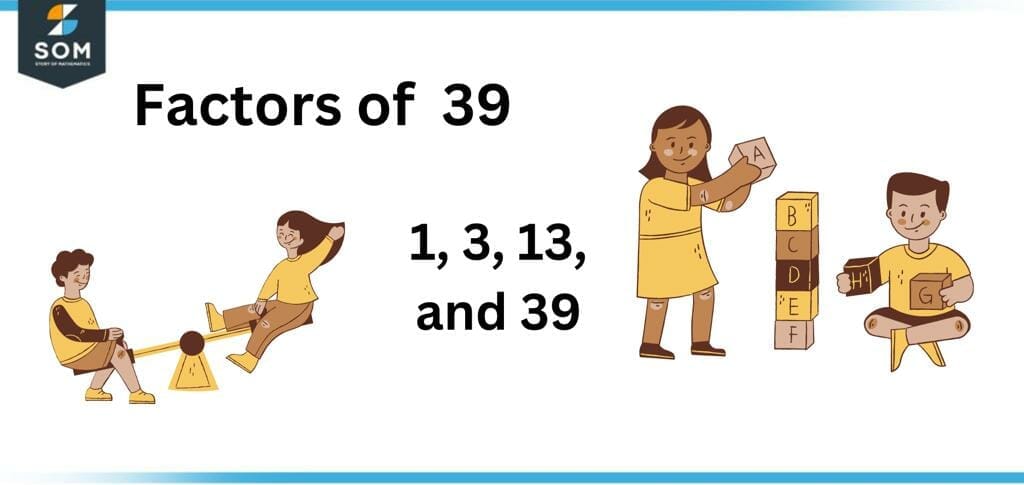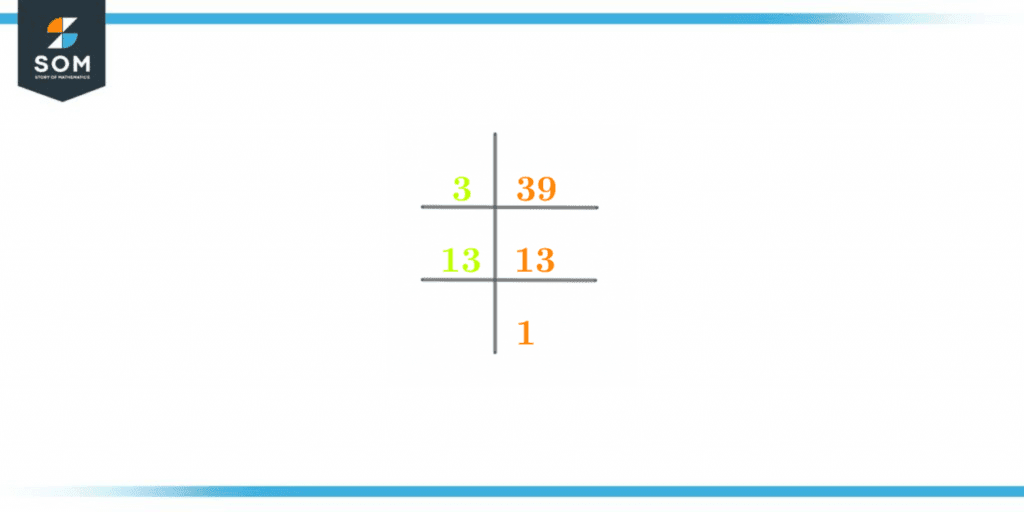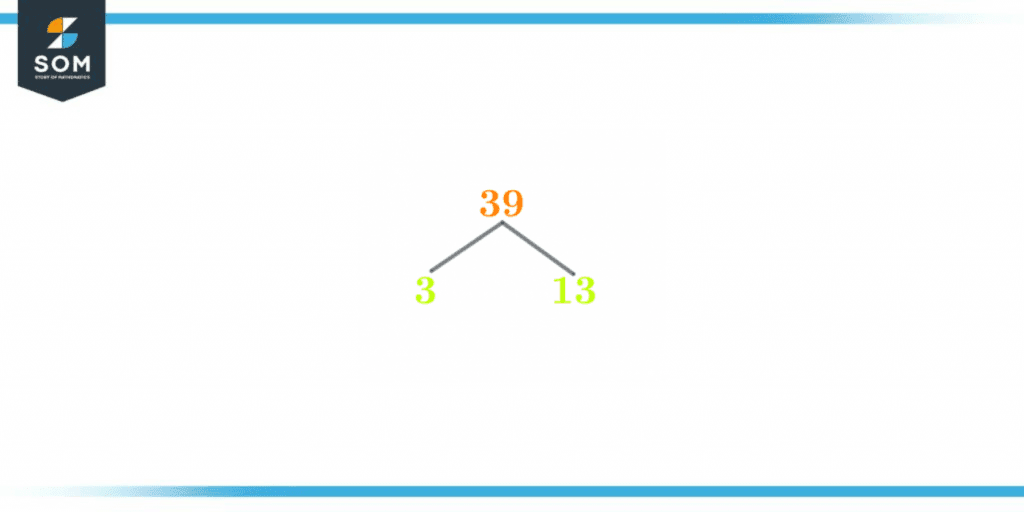JUMP TO TOPIC
Factors of 39: Prime Factorization, Methods, Tree, And Examples
Factors of 39 are the numbers upon which the number 39 is completely divisible, meaning that these numbers leave zero as the remainder when 39 is divided from them.
Figure 1 – All possible Factors of 39
What Are the Factors of 39?
The factors of 39 are 1, 3, 13, and 39. These are the numbers that all leave zero as the remainder when 39 is divided from them. They also leave a whole number quotient behind, which also acts as the factor.The number 39 has a total of 4 factors and these factors can be both positive as well as negative.How To Calculate the Factors of 39?
You can calculate the factors of 39 through various methods and techniques, but the most common method to calculate the factors of 39 is the division method. Before moving on to the division method, let’s first take a look at the general factors for all numbers.Factors
For all natural numbers, the smallest factor is always 1 and the largest factor is always the number itself. This statement can be applied to the number 39 as well. In the list of factors of 39, the smallest factor is 1 and the largest factor is 39 itself.Now, let’s move on to the division method. The condition of a number to be qualified as a factor is that the divisor should leave zero as the remainder and a whole number quotient with which it can form a factor pair.Keeping this in mind, let’s take a look at the division of 39 with two numbers – 2 and 3. This division is shown below:\[ \frac{39}{2} = 19.5 \]\[ \frac{39}{3} = 13 \]Since a whole number quotient is not produced when 39 is divided by 2, hence 2 cannot qualify as a factor for 39. As the number 3 produced a whole number quotient, which is 13, hence the number 3 is a factor of 39.As stated above, the whole number quotient produced can also act as the factor so let’s take a look at the division of 13 with 3:\[ \frac{39}{13} = 3\]This division proves that 13 is also a factor of 39. Additional factors of 39 are given below:\[ \frac{39}{1} = 39 \]\[ \frac{39}{39} = 1\]The list of all the factors of 39 is given below:Factors of 39: 1, 3, 13, 39These factors can be negative as well and these are given below:Negative Factors of 39 = -1, -3, -13, -39Factors of 39 by Prime Factorization
Prime Factorization is the division technique through which prime factors of a number are determined. As the name suggests, in prime factorization, the division is carried out with the help of prime numbers only.In prime factorization, the division begins with the number being a dividend and a prime number acting as the divisor that produces a whole number quotient. This whole number quotient then acts as the dividend in the next step and undergoes division with a respective prime number.The division process continues till in the end 1 is obtained as the whole number quotient. The result of 1 indicates that the prime factorization has come to an end.All the prime numbers which acted as the divisors during the division are then recognized as prime factors.The prime factorization of the number 39 is given below:39 $\div$ 3 = 13
13 $\div$ 13 = 1
Hence the number 39 consists of two prime factors and these are given below:Prime Factors of 39: 3, 13The prime factorization of 39 is also shown below in figure 1:
Figure 2 – Prime Factorization of 39
Factor Tree of 39
A factor tree is a pictorial way of representing the prime factors of a number. The factor tree can be considered as the visual representation of the prime factorization but instead of ending at 1, as in prime factorization, the factor tree ends at prime factors.The factor begins with the number itself and then extends its branches into a prime factor and a respective whole number quotient produced. This quotient then acts as the source and then branches out into a prime factor and another whole number. This process continues until only prime numbers are obtained at the end of both branches.The factor tree for the number 39 is shown below:
Figure 3 – Factor Tree of 39
Factors of 39 in Pairs
A factor pair is a pair of numbers that when multiplied together produce the original number as the result. An easy way to devise factor pairs for any number is to simply multiply a factor with its respective whole number quotient produced as the result of division.As the number 39 has 4 factors in total so this indicates that the factors of the number 39 can be divided into two-factor pairs. These factor pairs are given below:1 x 39 = 39
3 x 13 = 39
Factor Pairs of 39: (1, 39) and (3, 13)As the factors of the number 39 can be negative as well so the factor pairs of the number 39 can be negative as well.The only condition for negative factor pairs is that both the numbers need to have a negative sign so that when they are multiplied with each other, they can yield a positive product. The negative factor pairs of 39 are given below:-1 x -39 = 39
-3 x -13 = 39
Negative Factor Pairs of 39: (-1, -39) and (-3, -13)Some interesting facts about the number 39 are given below:- The number 39 is the sum of the 5 consecutive prime numbers which are: 3 + 5 + 7 + 11 + 13 = 39
- The number 39 is also the sum of the first three powers of 3: $3^{1}$ + $3^{2}$ + $3^{3}$ = 39
- Both the digits of the number 39 are divisible by 3 and their sum is also divisible by 3: 3 + 9 = 12
Factors of 39 Solved Examples
To further enhance the concept of factors of 39, given below are a few solved examples involving the factors of 39.Example 1
Determine the sum of all the factors of 39 and determine whether the resulting number is a multiple of 2 or 3.Solution
To determine the sum of all the factors of 39, let’s first list down all the factors of 39. The factors of 39 are given below:Factors of 39: 1, 3, 13, 39Next up, we will calculate the sum of these factors. Their sum is shown below:Sum of factors of 39 = 1 + 3 + 13 + 39
Sum of factors of 39 = 56
Hence, the sum of all the factors of 39 is 56. Now let’s determine if this number is a multiple of 2 or 3. Since the resulting number 56 is an even number so this indicates that the number 56 is divisible by 2. This division is shown below:\[\frac{56}{2} = 28\]Now let’s determine if 56 is a multiple of 3. An easy way to determine this is to simply add the digits and see if the resulting number is a multiple of 3.The sum of the digits of 56 is: 5 + 6 = 11
As the resulting number is 11 and it is not a multiple of 3, hence the number 56 is also not a multiple of 3.Therefore, the resulting number from the sum of factors of 39 is divisible by 2 only.Example 2
Calculate the average of all the odd factors of the number 39.Solution
For calculating the average of all the odd factors of 39, let’s first list down the factors of 39. The factors of 39 are:Factors of 39 = 1, 3, 13, 39Since all these numbers are odd factors, so we will be calculating their average. Odd factors of 39 = 1, 3, 13, 39This average of odd factors is given below:\[ Average = \frac{\text{Sum of all the odd factors}}{\text{Total number of odd factors}}\]\[ Average = \frac{1 + 3 + 13 + 39}{4} \]Average = $\frac{56}{4}$
Average = 14
Hence, the average of all the odd factors of the number 39 is 14. All images/mathematical drawings are created with GeoGebra.